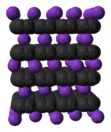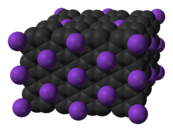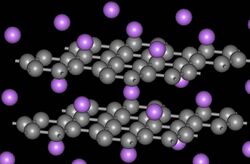Chemistry:Graphite intercalation compound
In the area of solid state chemistry. graphite intercalation compounds are materials prepared by intercalation of diverse guests into graphite. The materials have the formula (guest)Cn where n can range from 8 to 40's. The distance between the carbon layers increases significantly upon insertion of the guests. Common guests are reducing agents such as alkali metals. Strong oxidants, such as arsenic pentafluoride also intercalate into graphite. Intercalation involves electron transfer into or out of the host. The properties of these materials differ from those of the parent graphite.[1][2]
Preparation and structure
These materials are prepared by treating graphite with a strong oxidant or a strong reducing agent:
- C + m X → CX
m
The reaction is reversible.
The host (graphite) and the guest X interact by charge transfer. An analogous process is the basis of commercial lithium-ion batteries.
In a graphite intercalation compound not every layer is necessarily occupied by guests. In so-called stage 1 compounds, graphite layers and intercalated layers alternate and in stage 2 compounds, two graphite layers with no guest material in between alternate with an intercalated layer. The actual composition may vary and therefore these compounds are an example of non-stoichiometric compounds. It is customary to specify the composition together with the stage. The layers are pushed apart upon incorporation of the guest ions.
Examples
Alkali and alkaline earth derivatives
One of the best studied graphite intercalation compounds, KC
8, is prepared by melting potassium over graphite powder. The potassium is absorbed into the graphite and the material changes color from black to bronze.[3] The resulting solid is pyrophoric.[4] The composition is explained by assuming that the potassium to potassium distance is twice the distance between hexagons in the carbon framework. The bond between anionic graphite layers and potassium cations is ionic. The electrical conductivity of the material is greater than that of α-graphite.[4][5] KC
8 is a superconductor with a very low critical temperature Tc = 0.14 K.[6] Heating KC
8 leads to the formation of a series of decomposition products as the K atoms are eliminated:[citation needed]
- 3 KC
8 → KC
24 + 2 K
Via the intermediates KC
24 (blue in color),[3] KC
36, KC
48, ultimately the compound KC
60 results.
The stoichiometry MC
8 is observed for M = K, Rb and Cs. For smaller ions M = Li+
, Sr2+, Ba2+, Eu2+, Yb3+, and Ca2+, the limiting stoichiometry is MC
6.[6] Calcium graphite CaC
6 is obtained by immersing highly oriented pyrolytic graphite in liquid Li–Ca alloy for 10 days at 350 °C. The crystal structure of CaC
6 belongs to the R3m space group. The graphite interlayer distance increases upon Ca intercalation from 3.35 to 4.524 Å, and the carbon-carbon distance increases from 1.42 to 1.444 Å.
With barium and ammonia, the cations are solvated, giving the stoichiometry (Ba(NH
3)
2.5C
10.9(stage 1)) or those with caesium, hydrogen and potassium (CsC
8 · K
2H
4/3C
8(stage 1)).[clarification needed]
In situ adsorption on free-standing graphene and intercalation in bilayer graphene of the alkali metals K, Cs, and Li was observed by means of low-energy electron microscopy.[7]
Different from other alkali metals, the amount of Na intercalation is very small. Quantum-mechanical calculations show that this originates from a quite general phenomenon: among the alkali and alkaline earth metals, Na and Mg generally have the weakest chemical binding to a given substrate, compared with the other elements in the same group of the periodic table.[8] The phenomenon arises from the competition between trends in the ionization energy and the ion–substrate coupling, down the columns of the periodic table.[8] However, considerable Na intercalation into graphite can occur in cases when the ion is wrapped in a solvent shell through the process of co-intercalation. A complex magnesium(I) species has also been intercalated into graphite.[9]
Graphite bisulfate, perchlorate, hexafluoroarsenate: oxidized carbons
The intercalation compounds graphite bisulfate and graphite perchlorate can be prepared by treating graphite with strong oxidizing agents in the presence of strong acids. In contrast to the potassium and calcium graphites, the carbon layers are oxidized in this process:
- 48 C + 0.25 O2 + 3 H2SO4 → [C24]+[HSO4]−·2H2SO4 + 0.5 H2O[clarification needed]
In graphite perchlorate, planar layers of carbon atoms are 794 picometers apart, separated by ClO−
4 ions. Cathodic reduction of graphite perchlorate is analogous to heating KC
8, which leads to a sequential elimination of HClO
4.
Both graphite bisulfate and graphite perchlorate are better conductors as compared to graphite, as predicted by using a positive-hole mechanism.[4]
Reaction of graphite with [O
2]+
[AsF
6]−
affords the salt [C
8]+
[AsF
6]−
.[4]
Metal halide derivatives
A number of metal halides intercalate into graphite. The chloride derivatives have been most extensively studied. Examples include MCl
2 (M = Zn, Ni, Cu, Mn), MCl
3 (M = Al, Fe, Ga), MCl
4 (M = Zr, Pt), etc.[1] The materials consists of layers of close-packed metal halide layers between sheets of carbon. The derivative C
~8FeCl
3 exhibits spin glass behavior.[10] It proved to be a particularly fertile system on which to study phase transitions.[citation needed] A stage n magnetic graphite intercalation compounds has n graphite layers separating successive magnetic layers. As the stage number increases the interaction between spins in successive magnetic layers becomes weaker and 2D magnetic behaviour may arise.
Halogen- and oxide-graphite compounds
Chlorine and bromine reversibly intercalate into graphite. Iodine does not. Fluorine reacts irreversibly. In the case of bromine, the following stoichiometries are known: C
nBr for n = 8, 12, 14, 16, 20, and 28.
Because it forms irreversibly, carbon monofluoride is often not classified as an intercalation compound. It has the formula (CF)
x. It is prepared by reaction of gaseous fluorine with graphitic carbon at 215–230 °C. The color is greyish, white, or yellow. The bond between the carbon and fluorine atoms is covalent. Tetracarbon monofluoride (C
4F) is prepared by treating graphite with a mixture of fluorine and hydrogen fluoride at room temperature. The compound has a blackish-blue color. Carbon monofluoride is not electrically conductive. It has been studied as a cathode material in one type of primary (non-rechargeable) lithium batteries.
Graphite oxide is an unstable yellow solid.
Properties and applications
Graphite intercalation compounds have fascinated materials scientists for many years owing to their diverse electronic and electrical properties.
Superconductivity
Among the superconducting graphite intercalation compounds, CaC
6 exhibits the highest critical temperature Tc = 11.5 K, which further increases under applied pressure (15.1 K at 8 GPa).[6] Superconductivity in these compounds is thought to be related to the role of an interlayer state, a free electron like band lying roughly 2 eV (0.32 aJ) above the Fermi level; superconductivity only occurs if the interlayer state is occupied.[11] Analysis of pure CaC
6 using a high quality ultraviolet light revealed to conduct angle-resolved photoemission spectroscopy measurements. The opening of a superconducting gap in the π* band revealed a substantial contribution to the total electron–phonon-coupling strength from the π*-interlayer interband interaction.[11]
Reagents in chemical synthesis: KC
8
The bronze-colored material KC
8 is one of the strongest reducing agents known. It has also been used as a catalyst in polymerizations and as a coupling reagent for aryl halides to biphenyls.[12] In one study, freshly prepared KC
8 was treated with 1-iodododecane delivering a modification (micrometre scale carbon platelets with long alkyl chains sticking out providing solubility) that is soluble in chloroform.[12] Another potassium graphite compound, KC
24, has been used as a neutron monochromator. A new essential application for potassium graphite was introduced by the invention of the potassium-ion battery. Like the lithium-ion battery, the potassium-ion battery should use a carbon-based anode instead of a metallic anode. In this circumstance, the stable structure of potassium graphite is an important advantage.
See also
- Buckminsterfullerene intercalates
- Covalent superconductors
- Magnesium diboride, which uses hexagonal planar boron sheets instead of carbon
- Pyrolytic graphite
References
- ↑ 1.0 1.1 Greenwood, Norman N.; Earnshaw, Alan (1997). Chemistry of the Elements (2nd ed.). Butterworth-Heinemann. ISBN 978-0-08-037941-8.
- ↑ H-P Boehm et al. (1994). "Nomenclature and terminology of graphite intercalation compounds". Pure and Applied Chemistry 66 (9): 1893. doi:10.1351/pac199466091893. Archived from the original on 2012-04-06. https://web.archive.org/web/20120406105828/http://www.iupac.org/publications/pac/1994/pdf/6609x1893.pdf.
- ↑ 3.0 3.1 Ottmers, D.M.; Rase, H.F. (1966). "Potassium graphites prepared by mixed-reaction technique". Carbon 4 (1): 125–127. doi:10.1016/0008-6223(66)90017-0. ISSN 0008-6223.
- ↑ 4.0 4.1 4.2 4.3 Catherine E. Housecroft; Alan G. Sharpe (2008). "Chapter 14: The group 14 elements". Inorganic Chemistry, 3rd Edition. Pearson. p. 386. ISBN 978-0-13-175553-6.
- ↑ NIST Ionizing Radiation Division 2001 – Major Technical Highlights. physics.nist.gov
- ↑ 6.0 6.1 6.2 Emery, N. et al. (2008). "Review: Synthesis and superconducting properties of CaC6". Science and Technology of Advanced Materials 9 (4): 044102. doi:10.1088/1468-6996/9/4/044102. PMID 27878015. Bibcode: 2008STAdM...9d4102E.
- ↑ Lorenzo, Marianna; Escher, Conrad; Latychevskaia, Tatiana; Fink, Hans-Werner (2018-05-07). "Metal Adsorption and Nucleation on Free-Standing Graphene by Low-Energy Electron Point Source Microscopy". Nano Letters (American Chemical Society (ACS)) 18 (6): 3421–3427. doi:10.1021/acs.nanolett.8b00359. PMID 29733660. Bibcode: 2018NanoL..18.3421L.
- ↑ 8.0 8.1 Liu, Yuanyue; Merinov, Boris V.; Goddard, William A. (5 April 2016). "Origin of low sodium capacity in graphite and generally weak substrate binding of Na and Mg among alkali and alkaline earth metals". Proceedings of the National Academy of Sciences 113 (14): 3735–3739. doi:10.1073/pnas.1602473113. PMID 27001855. Bibcode: 2016PNAS..113.3735L.
- ↑ Xu, Wei; Zhang, Hanyang; Lerner, Michael M. (2018-06-25). "Graphite Intercalation by Mg Diamine Complexes". Inorganic Chemistry (American Chemical Society (ACS)) 57 (14): 8042–8045. doi:10.1021/acs.inorgchem.8b01250. ISSN 0020-1669. PMID 29939016.
- ↑ Millman, S E; Zimmerman, G O (1983). "Observation of spin glass state in FeCl3: intercalated graphite". Journal of Physics C: Solid State Physics 16 (4): L89. doi:10.1088/0022-3719/16/4/001. Bibcode: 1983JPhC...16L..89M.
- ↑ 11.0 11.1 Csányi et al. (2005). "The role of the interlayer state in the electronic structure of superconducting graphite intercalated compounds". Nature Physics 1 (1): 42–45. doi:10.1038/nphys119. Bibcode: 2005NatPh...1...42C.
- ↑ 12.0 12.1 Chakraborty, S. et al. (2007). "Functionalization of Potassium Graphite". Angewandte Chemie International Edition 46 (24): 4486–8. doi:10.1002/anie.200605175. PMID 17477336.
Further reading
- T. Enoki, M. Suzuki and M. Endo (2003). Graphite intercalation compounds and applications. Oxford University Press. ISBN 978-0-19-512827-7.
- Dresselhaus, M.S.; Dresselhaus, G. (1981). "Intercalation compounds of graphite". Advances in Physics 30 (2): 139–326. doi:10.1080/00018738100101367. Bibcode: 1981AdPhy..30..139D. (187 pages), also reprinted as Dresselhaus, M. S.; Dresselhaus, G. (2002). "Intercalation compounds of graphite". Advances in Physics 51 (1): 1–186. doi:10.1080/00018730110113644. Bibcode: 2002AdPhy..51....1D.
- D. Savoia et al. (1985). "Applications of potassium-graphite and metals dispersed on graphite in organic synthesis". Pure and Applied Chemistry 57 (12): 1887. doi:10.1351/pac198557121887. http://www.iupac.org/publications/pac/1985/pdf/5712x1887.pdf.
- Suzuki, Itsuko S.; Ting-Yu Huang; Masatsugu Suzuki (13 June 2002). "Magnetic phase diagram of the stage-1 CoCl2 graphite intercalation compound: Existence of metamagnetic transition and spin-flop transitions". Physical Review B 65 (22): 224432. doi:10.1103/PhysRevB.65.224432. Bibcode: 2002PhRvB..65v4432S.
- Rancourt, DG; C Meschi; S Flandrois (1986). "S=1/2 antiferromagnetic finite chains effectively isolated by frustration: CuCl2-intercalated graphite.". Physical Review B 33 (1): 347–355. doi:10.1103/PhysRevB.33.347. PMID 9937917. Bibcode: 1986PhRvB..33..347R.
 |





